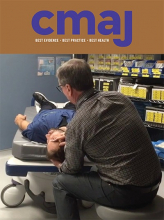Jump to comment:
- Page navigation anchor for The Bow & Rise test: a convenient alternative to Dx-HallpikeThe Bow & Rise test: a convenient alternative to Dx-Hallpike
Sir,
This excellent paper sets a gold standard for assessing and managing vertigo. While in the Emergency Room (the setting of this study) patients are likely to be on trolleys already and so in place for Dix-Hallpike testing, in General Practice, the move to a couch can be time consuming and awkward, especially when patients are less mobile.
I have previously described an alternate test, the Bow & Rise Test (1) (2)which can be carried out with the patient seated and involves simply asking the patient to turn the saggital axis of the head to 45 degrees thereby isolating the posterior semicircular canal under test, then, in this position, bow to move the head to horizontal and then quickly return to vertical, causing rotational movement in the canal. Where a patient experiences vertigo, the test is positive on that side, thereby informing on which side an Epley Manoeuvre should be carted out.1. Ashworth AJ Bow and rise test leaves time for Epley in a 10 minute consultation BJGP 2019 https://bjgp.org/content/bow-and-rise-test-leaves-time-epley-10-minute-c...
2. https://youtu.be/8FpxLPu_JCUCompeting Interests: None declared. - Page navigation anchor for RE: Vestibular neuritisRE: Vestibular neuritis
As a 77 year old retired General Practitioner who had acute vestibular neuritis in 1980, with permanent
Show More
dizziness and balance disturbance as a consequence, the article and video demonstrations were of great interest to me. At the time of original illness, I had been seeing a spike of vertigo cases in my practice, all of whom recovered completely. My ENT and neurology specialist assessments suggested the above diagnosis with a putative viral origin. Subsequently, I would have days where dizziness and balance were extra problematic, needing the use of a cane. Then 10 years ago after an extremely severe dizzy day accompanied by visual disturbance resolving in 24 hours, I gradually realized that a residual visual problem was present. It took a month for me to be able to work out and describe the symptom: I had lost my steady cam. This was the best I could do to put into words that the horizon was no longer stable on walking, but would move up and down slightly, the phenomenon known as oscillopsia. None of my GP colleagues were aware of this entity and I suspect that our patients would have much difficulty getting the message across to us if they were to develop this disorder. Of added interest is that my female maternal cousin of similar age also suffered acute vestibular neuritis a few years ago and subsequently developed oscillopsia (this word had not been used to her by any of her physicians). It seems odd that an entity said to be as rare as hens' teeth...Competing Interests: None declared.











